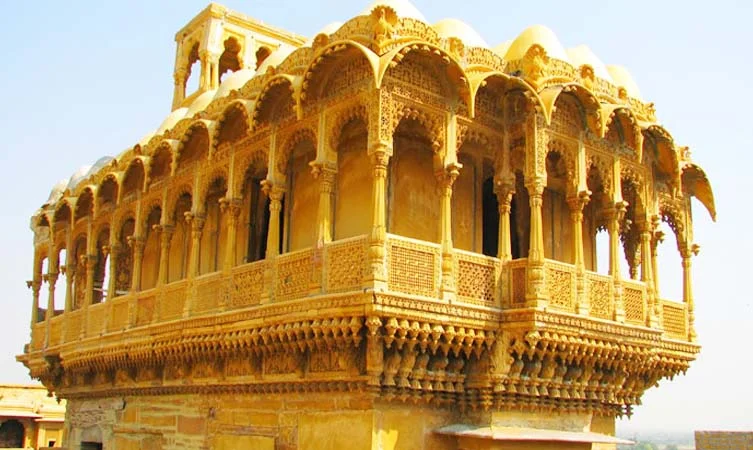Jaisalmer, known as the Golden City of India, is a treasure trove of architectural marvels. Among its many attractions, the havelis—traditional mansions built by wealthy merchants—stand out as extraordinary examples of intricate craftsmanship and historical significance. These havelis are more than just buildings; they are a testament to the cultural, artistic, and economic history of Jaisalmer. Let’s embark on a journey to explore the grandeur of these iconic structures.
What Makes Jaisalmer’s Havelis Unique?
Jaisalmer’s havelis are renowned for their yellow sandstone architecture that glows like gold under the desert sun. They feature elaborate carvings, jharokhas (overhanging enclosed balconies), and courtyards that reflect the artistic prowess of the artisans of that era. Each haveli tells a unique story of the merchant families who commissioned them, blending elements of Rajasthani and Mughal architectural styles.
Must-Visit Havelis in Jaisalmer
Here are some of the most famous havelis you should explore during your visit:
- Patwon Ki Haveli
- This is the largest haveli in Jaisalmer and a cluster of five smaller havelis. Built in the 19th century, it is known for its stunning latticework and mirror work. Patwon Ki Haveli offers a glimpse into the opulence of its wealthy owners, who were prominent traders in textiles and precious items.
- Salim Singh Ki Haveli
- Constructed in the early 18th century, this haveli is distinctive for its peacock-shaped roof and exquisite stone carvings. The architecture of Salim Singh Ki Haveli demonstrates the advanced engineering skills of the time, making it a must-see.
- Nathmal Ki Haveli
- Built by two brothers, Nathmal Ki Haveli is famous for its symmetry and fine detailing. While one brother worked on the left side and the other on the right, their combined efforts resulted in a breathtakingly intricate façade adorned with carvings of elephants, flowers, and birds.
The Craftsmanship Behind the Havelis
One of the most remarkable features of Jaisalmer’s havelis is the craftsmanship that went into their construction. Skilled artisans meticulously chiseled yellow sandstone into ornate patterns, creating intricate screens and decorative panels. These carvings not only enhanced the aesthetic appeal but also served practical purposes, such as providing ventilation and shade from the harsh desert sun.
How to Explore Jaisalmer’s Havelis
To truly appreciate the beauty and history of these havelis, it’s best to explore them with a local guide. A knowledgeable guide can share fascinating anecdotes and insights into the lives of the families who lived there and the artisans who brought these structures to life. You can easily book a Taxi Service in Jaisalmer for a comfortable and convenient tour of the city’s iconic landmarks, including these havelis.
The Role of Havelis in Jaisalmer’s Cultural Heritage
Havelis were not just residences; they were symbols of wealth and status. They played a significant role in shaping the cultural and social fabric of Jaisalmer. The havelis’ open courtyards often hosted community gatherings, while their intricately carved facades were designed to showcase the owner’s affluence and appreciation for art.
Tips for Visiting Jaisalmer’s Havelis
Here are a few tips to ensure you make the most of your visit to these architectural wonders:
- Wear Comfortable Shoes: The narrow lanes and uneven surfaces around the havelis require good footwear.
- Carry Water: Jaisalmer’s arid climate can be dehydrating, so keep water handy.
- Visit Early or Late: To avoid the crowds and the midday heat, plan your visit during the morning or late afternoon.
- Hire a Local Guide: They can provide in-depth information about the history and significance of each haveli.
Other Attractions Near Jaisalmer’s Havelis
While exploring the havelis, don’t miss out on other nearby attractions, such as:
- Jaisalmer Fort: Known as Sonar Quila, this living fort houses numerous shops, temples, and residential buildings.
- Gadisar Lake: A tranquil spot surrounded by ghats and temples, ideal for photography and boat rides.
- Local Markets: The bustling bazaars near the havelis offer traditional handicrafts, textiles, and souvenirs.
Sustainable Tourism and Preservation Efforts
It’s essential to visit Jaisalmer’s havelis responsibly to ensure their preservation for future generations. Avoid touching or leaning on the delicate carvings, and support local initiatives that promote sustainable tourism. Many of these havelis are undergoing restoration to protect them from the effects of time and weather, and your mindful visit contributes to their conservation.
How to Plan Your Jaisalmer Haveli Tour
Planning your trip to Jaisalmer’s havelis can be seamless with the right resources. Opt for a reliable Jaisalmer Sightseeing Taxi service to navigate the city comfortably. These services offer customizable tours, allowing you to explore the havelis at your own pace while also visiting other notable landmarks.
Conclusion
Jaisalmer’s havelis are architectural masterpieces that offer a window into the city’s rich history and cultural heritage. Whether it’s the intricate carvings, the fascinating stories, or the sheer grandeur of these structures, a visit to these havelis is an unforgettable experience. By exploring these gems, you not only immerse yourself in the legacy of Jaisalmer but also contribute to preserving its timeless beauty for generations to come.
Let the splendor of Jaisalmer’s havelis inspire your next journey to this enchanting desert city.

